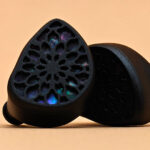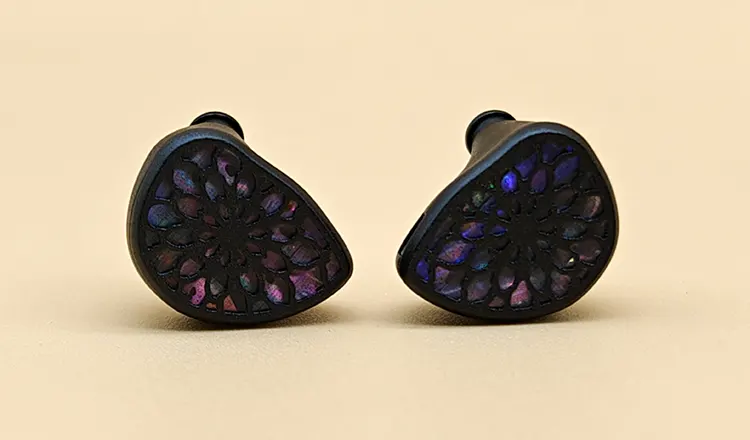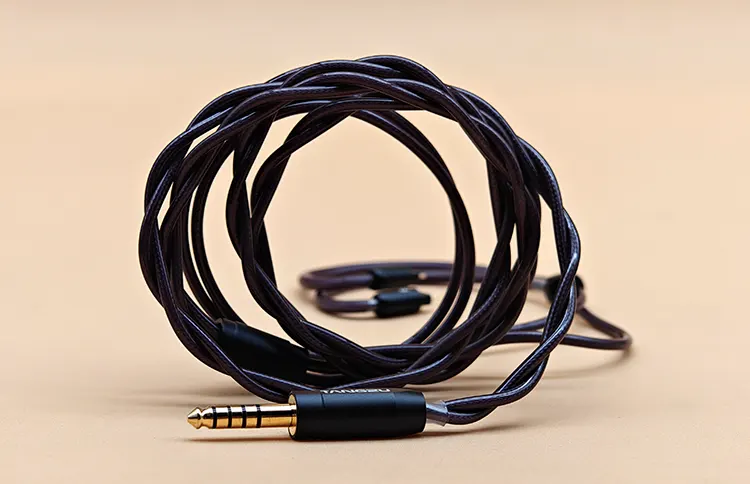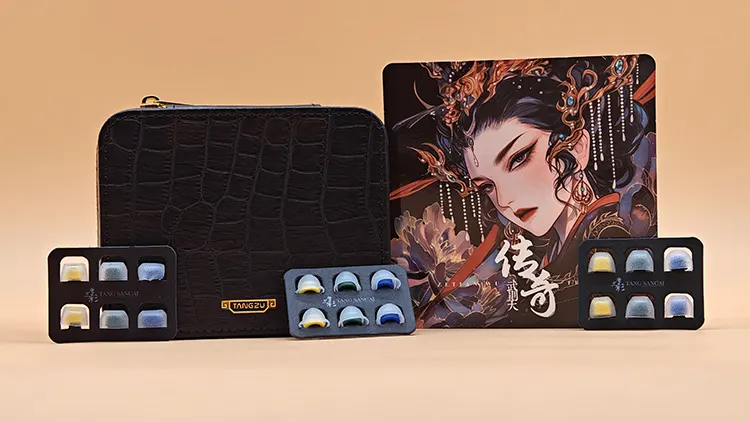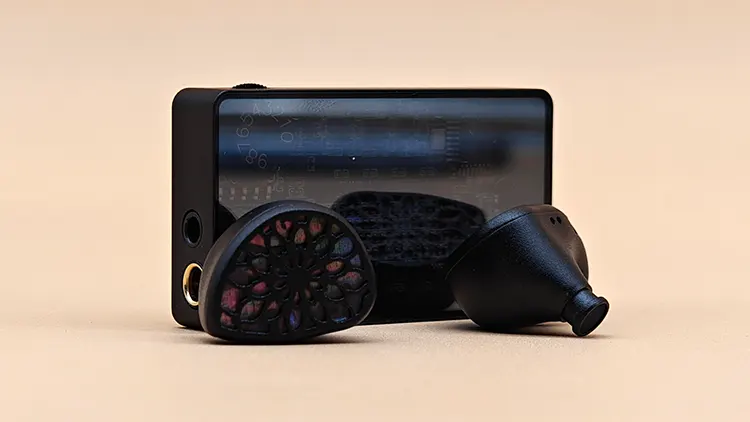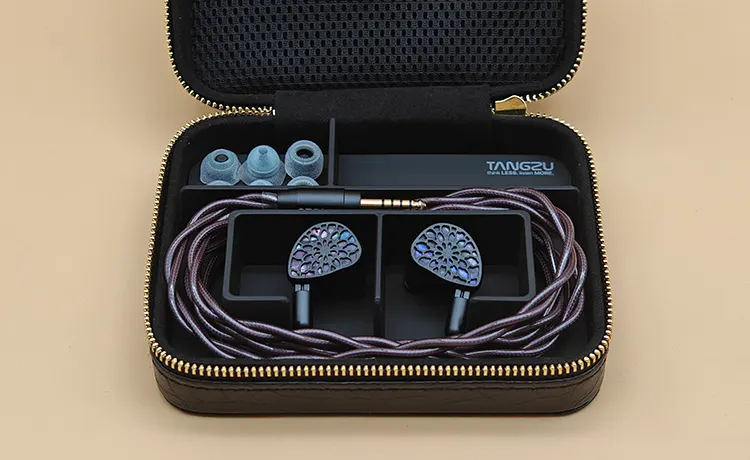In this feature, Kurt reviews the TANGZU Zetian Wu Legend, a 2nd generation dual-planar driver IEM with an attractive Abalone-like finish. It is currently priced at $259.
Disclaimer: I received this sample in exchange for my honest opinion. Headfonics is an independent website with no affiliate links or services. I thank TANGZU and Linsoul for their support.
You can click here to learn more about Linsoul’s provided gear previously reviewed on Headfonics.
This post follows our current scoring guidelines, which you can read in more detail here.
When the Tangzu Zetian Wu was first launched, it quickly became a go-to planar IEM with its unique tuning and engaging sound. It stood out by delivering natural timbre, musicality, and near flawless balance at an affordable price.
Despite sharing its predecessor’s name, the $259 Tangzu Zetian Wu Legend isn’t positioned as a direct successor but carries forward its unique purple lotus design.
Now, featuring a dual-driver configuration and a higher price tag, does the Zetian Wu Legend live up to its prestigious name, and how does it compete with planar entries such as the LETSHUOER S12 2024 Edition and the 7Hz Timeless II?
Features
The Tangzu Zetian Wu Legend takes a different approach by using two planar drivers instead of one. It houses a 14.2mm planar driver and a 6mm flat diaphragm planar driver inside its compact shell.
The 14.2mm driver isn’t the largest Tangzu has used, as the original Zetian had a slightly bigger 14.5mm driver. Despite this, the addition of a secondary planar unit is a unique change while keeping the overall size similar.
The larger planar driver handles the bass, midrange, and treble, acting as the main powerhouse of the sound. The 6mm flat diaphragm driver focuses on the upper treble and air frequencies, improving clarity and detail.
Tangzu added this extra driver to reduce the workload on the main driver. The original Zetian Wu never had workload issues, but this upgrade is a welcome one as it aims to bring even better precision to the Zetian Wu Legend’s sound.
Design
The Tangzu Zetian Wu Legend features a durable aluminum alloy shell without any sharp or pointed edges, giving it a strong yet comfortable build. It is only available in black, with its faceplate serving as the standout design element.
Tangzu continues the lotus-inspired theme from the original Zetian Wu but with a twist. Instead of an engraved pattern, the faceplate now features a lotus cutout with a colorful abalone-like material underneath as its centerpiece.
Under normal lighting, the faceplate displays various shades of purple, paying homage to the original Zetian Wu’s signature look. However, at certain angles, a full spectrum of colors appears, creating a striking rainbow effect.
In Chinese culture, abalones are associated with good fortune, making this design choice more than just aesthetic. Whether intentional or not, the Zetian Wu Legend could serve as a subtle lucky charm when one wears it.
The matte shell provides a smooth, non-sticky surface that remains comfortable to the touch. However, it absorbs temperature easily, making it noticeably hot or cold depending on the environment.
For managing air pressure, the Zetian Wu Legend includes three vents in the shell. Two are positioned near the 0.78mm connectors, while a third sits near the “L” and “R” markings on the shell.
Comfort & Isolation
Since the Tangzu Zetian Wu Legend keeps the same overall shape as the original Zetian, comfort remains excellent. The aluminum shell rests naturally on the ears, forming a secure seal without any effort.
Most users will find the fit hassle-free, as its size is neither bulky nor awkward. Despite using a denser aluminum shell instead of the original Zetian’s 3D-printed resin, it remains lightweight and unobtrusive.
Its smooth, rounded design eliminates any sharp edges or rough textures, making it easy to wear for long sessions. The weight distribution between the IEM and cable also helps it feel almost weightless during use.
The nozzle isn’t overly large, but its shorter length sometimes requires a deeper insertion with shorter tips. Thankfully, the added nozzle lip keeps ear tips secure, preventing any risk of them slipping off inside the ears.
Ear Tips
The Tangzu Wu Zetian Legend comes with three sets of Tang Sancai ear tips, each offering different sound experiences. They come in yellow, green, and blue, representing large, medium, and small sizes, with wide bore, balanced, and narrow bore designs, respectively.
The narrow bore ear tips performed the worst, despite providing a solid seal. They heavily altered the sound, masking details, clouding the midrange, and making vocals sound unnatural.
Treble performance also took a hit with the narrow bore tips, stripping away the expected planar detail retrieval. It dulled the highs significantly, making the overall sound less engaging and resolving.
Switching to the balanced ear tips instantly restored clarity, allowing the Zetian Wu Legend’s planar qualities to shine. The sound became more open and natural, bringing back the original tuning instantly.
The wide bore ear tips further enhanced this experience by boosting subbass presence and treble sparkle. Rumbles became more enjoyable, while the added air gave instruments and vocals extra life.
Comfort and fit were excellent across all three sets, thanks to their unique texture and premium feel. While all were well-made, the wide bore ear tips delivered the best sound experience, making them my top choice.
Stock Cable
The Tangzu Zetian Wu Legend improves on its stock cable in nearly every way except for modularity. Instead of a 3.5mm termination, it includes a 4.4mm balanced connector, which is the better choice for a planar IEM.
This time, Tangzu upgraded the cable to a shielded LNOFC Litz design, a significant step up from the original Zetian’s OFC cable. The added shielding helps minimize distortion and static, ensuring a cleaner signal from various sources.
Its dark purple color complements the IEM’s aesthetic, with a two-braid design running from the 4.4mm connector to the splitter. After the splitter, it transitions into single strands leading to the left and right 0.78mm pins.
For convenience, the left and right connectors are clearly labeled with “L” and “R.” The splitter also features the Tangzu branding, adding a subtle yet premium touch to the overall design.
The cable’s feel and weight are excellent, rivaling high-end aftermarket options in both durability and flexibility. It remains tangle-free and lightweight, making it an ideal match for the equally lightweight Zetian Wu Legend.
Packaging & Accessories
The front of the Tangzu Zetian Wu Legend’s box features an artistic rendering of Empress Zetian Wu. On the back, a Chinese dragon in a purple accent is displayed, with product details like impedance and sensitivity neatly placed in the bottom left corner.
Sliding off the cover reveals a gold-accented “Zetian Wu The Legend” text, adding a touch of elegance to the presentation. A Chinese character sits between the words, though its exact translation remains unknown, it likely says the same meaning.
The inner box carries Tangzu’s branding along with the tagline “Think Less. Listen More” on the side. It opens like a book from right to left, unveiling the accessories and IEMs in an organized layout.
A square photo card of Empress Zetian Wu sits atop the leather-like carrying case, adding a collectible element to the unboxing. The case itself has a refined, purse-like aesthetic, blending style with functionality.
At the center of the display, the Zetian Wu Legend comes pre-attached to its stock cable. Removing the carrying case and foam cutout reveals the rest of the cable along with the three sets of Sancai ear tips.
Sound Impressions
Bass
The bass of the Tangzu Zetian Wu Legend delivers a solid performance but never truly stands out. Subbass offers a decent rumble that keeps the sound from feeling dry, yet its decay is too fast to fully appreciate its depth.
The midbass lacks the impact needed for a satisfying punch, causing bass guitars to sound muted and blunted. Instead of delivering a powerful slam, it comes across as a light thud that is often overwhelmed by the subbass.
Due to the weaker midbass, the low-end presence can feel underwhelming and sometimes becomes an afterthought in the mix. It rarely grabs attention or elevates the overall sound as it struggles to match the liveliness of the high-end.
On the upside, bass note definition is excellent, with textures that remain detailed rather than overly smoothed out. Its cleanliness ensures there’s no bleed into the midrange, allowing the mids and treble to shine without interference.
Mids
The Tangzu Zetian Wu Legend’s midrange has a noticeable metallic timbre, making female vocals sound slightly unnatural. Male vocals, however, maintain a more natural tone and don’t suffer from the same issue.
A sharpness in the upper midrange makes female vocals occasionally grating, which could be fatiguing for those sensitive to sibilance. While the added breathiness enhances airiness and liveliness, it can sometimes feel excessive, pushing the midrange into an overly bright presentation.
But vocal nuances are captured well, with clear note definition that highlights subtle details in the performance. The note weight is balanced, avoiding a thin or dry presentation while still keeping enough body for an engaging experience.
Clarity is a strong point, but the vocals can become overbearing due to the strong upper midrange emphasis. This added intensity possibly contributes to the metallic timbre, making the presentation occasionally shouty.
Treble
The benefits of the 6mm flat diaphragm planar driver in the Tangzu Zetian Wu Legend come through in its treble presentation. It delivers impressive sparkle and air, adding definition and energy to the overall sound.
Treble extension is strong, offering high detail retrieval that brings out every subtle nuance in the mix. It outperforms many other planar IEMs in microdetail clarity, making hidden elements stand out effortlessly.
However, the treble doesn’t sound completely natural, likely receiving a slight boost to enhance its resolution. This added emphasis may contribute to the noticeable sibilance that bleeds into the upper midrange.
I enjoy the extra energy it brings, as instruments gain an additional layer of shimmer and liveliness. However, some listeners may find it overbearing, as the combination of sibilance and strong treble energy can be overwhelming.
Staging & Dynamics
The soundstage of the Tangzu Zetian Wu Legend is average, with a stage width slightly above normal and a height that remains average. The experience is in-head, unable to offer an expansive experience.
The staging primarily delivers horizontal imaging since it has limited capabilities for depth and height separation. It makes a lot of sounds placed correctly, but the overall presentation never feels truly immersive.
The imaging does a good job of positioning vocals and instruments accurately, but the constrained staging limits its potential for spaciousness. It’s still enjoyable, though it doesn’t provide the expansive sound to elevate the listening experience.
Dynamics are a strong suit, with the mids and treble taking the spotlight without clashing. The bass consistently plays a supportive role, adding just enough low end to balance the overall mix.
The focus on the high end is clear, with vocals remaining intimate and instruments sounding vibrant. Together, they deliver a truly detailed experience that remains consistent at any volume.
Click on page 2 below for my recommended pairings and selected comparisons.


